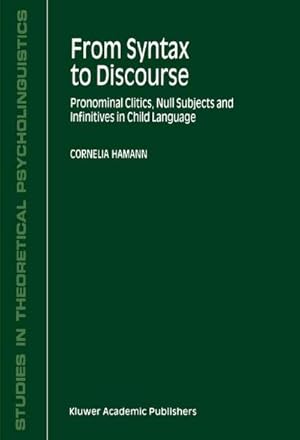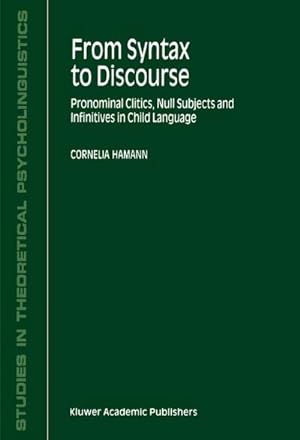9781402004407 - From Syntax to Discourse: Pronominal Clitics, Null Subjects and Infinitives in Child Language de Hamann, C. (8 résultats)
CommentairesFiltres de recherche
Type d'article
- Tous les types de produits
- Livres (8)
- Magazines & Périodiques (Aucun autre résultat ne correspond à ces critères)
- Bandes dessinées (Aucun autre résultat ne correspond à ces critères)
- Partitions de musique (Aucun autre résultat ne correspond à ces critères)
- Art, Affiches et Gravures (Aucun autre résultat ne correspond à ces critères)
- Photographies (Aucun autre résultat ne correspond à ces critères)
- Cartes (Aucun autre résultat ne correspond à ces critères)
- Manuscrits & Papiers anciens (Aucun autre résultat ne correspond à ces critères)
Etat En savoir plus
- Neuf (7)
- Comme neuf, Très bon ou Bon (1)
- Assez bon ou satisfaisant (Aucun autre résultat ne correspond à ces critères)
- Moyen ou mauvais (Aucun autre résultat ne correspond à ces critères)
- Conformément à la description (Aucun autre résultat ne correspond à ces critères)
Reliure
- Toutes
- Couverture rigide (Aucun autre résultat ne correspond à ces critères)
- Couverture souple (8)
Particularités
- Ed. originale (Aucun autre résultat ne correspond à ces critères)
- Signé (Aucun autre résultat ne correspond à ces critères)
- Jaquette (Aucun autre résultat ne correspond à ces critères)
- Avec images (4)
- Sans impressions à la demande (5)
Langue (1)
Prix
- Tous les prix
- Moins de EUR 20 (Aucun autre résultat ne correspond à ces critères)
- EUR 20 à EUR 45 (Aucun autre résultat ne correspond à ces critères)
- Plus de EUR 45
Livraison gratuite
- Livraison gratuite à destination de France (Aucun autre résultat ne correspond à ces critères)
Pays
Evaluation du vendeur
-
From Syntax to Discourse: Pronominal Clitics, Null Subjects and Infinitives in Child Language (Studies in Theoretical Psycholinguistics, 29)
Vendeur : Ria Christie Collections, Uxbridge, Royaume-Uni
EUR 165,19
Autre deviseEUR 4,60 expédition depuis Royaume-Uni vers FranceQuantité disponible : Plus de 20 disponibles
Ajouter au panierEtat : New. In.
-
From Syntax to Discourse: Pronominal Clitics, Null Subjects and Infinitives in Child Language (Studies in Theoretical Psycholinguistics)
Vendeur : Chiron Media, Wallingford, Royaume-Uni
EUR 162,31
Autre deviseEUR 10,93 expédition depuis Royaume-Uni vers FranceQuantité disponible : 10 disponible(s)
Ajouter au panierPaperback. Etat : New.
-
From Syntax to Discourse : Pronominal Clitics, Null Subjects and Infinitives in Child Language
Edité par Springer Netherlands, Springer Netherlands, 2002
ISBN 10 : 1402004400 ISBN 13 : 9781402004407
Langue: anglais
Vendeur : AHA-BUCH GmbH, Einbeck, Allemagne
EUR 168,73
Autre deviseEUR 10,99 expédition depuis Allemagne vers FranceQuantité disponible : 1 disponible(s)
Ajouter au panierTaschenbuch. Etat : Neu. Druck auf Anfrage Neuware - Printed after ordering - claim is that such morphological processes can be learnt without symbolization and innate knowledge. See Rumelhart and McClelland (1986) for the original model of past tense acquisition, Plunkett and Marchman (1993), Nakisa, Plunkett and Hahn (1996) and Elman et al. (1996) for developments and extensions to other morphological processes, and Marcus et al. (1992) and Pinker and Prince (1988) for criticism. One line of investigation supporting the view of language as a genetic endowment is closely linked to traditional research on language acquisition and argues as follows: If language is innate there must be phenomena that should be accessible from birth in one form or the other. Thus it is clear that the language of children, especially young children and preferably babies should be investigated. As babies unfortunately don't talk, the abilities that are available from birth must be established in ways different from the usual linguistic analysis. Psycholinguistic research of the last few years has shown that at the age of 4 and 8 months and even during their first week of life children already have important language skills. From the fourth day, infants distinguish their mother tongue from other languages. From the first months children prefer the sound of speech to 'other noise'. At the age of 4 months, infants prefer pauses at syntactic boundaries to random pauses.
-
From Syntax to Discourse: Pronominal Clitics, Null Subjects and Infinitives in Child Language (Studies in Theoretical Psycholinguistics, 29)
Vendeur : Lucky's Textbooks, Dallas, TX, Etats-Unis
EUR 157,87
Autre deviseEUR 64,23 expédition depuis Etats-Unis vers FranceQuantité disponible : Plus de 20 disponibles
Ajouter au panierEtat : New.
-
From Syntax to Discourse: Pronominal Clitics, Null Subjects and Infinitives in Child Language (Studies in Theoretical Psycholinguistics, 29)
Vendeur : Mispah books, Redhill, SURRE, Royaume-Uni
EUR 226,62
Autre deviseEUR 28,80 expédition depuis Royaume-Uni vers FranceQuantité disponible : 1 disponible(s)
Ajouter au panierPaperback. Etat : Like New. Like New. book.
-
From Syntax to Discourse
Edité par Springer Netherlands Jan 2002, 2002
ISBN 10 : 1402004400 ISBN 13 : 9781402004407
Langue: anglais
Vendeur : BuchWeltWeit Ludwig Meier e.K., Bergisch Gladbach, Allemagne
EUR 64,15
Autre deviseEUR 11 expédition depuis Allemagne vers FranceQuantité disponible : 2 disponible(s)
Ajouter au panierTaschenbuch. Etat : Neu. This item is printed on demand - it takes 3-4 days longer - Neuware -claim is that such morphological processes can be learnt without symbolization and innate knowledge. See Rumelhart and McClelland (1986) for the original model of past tense acquisition, Plunkett and Marchman (1993), Nakisa, Plunkett and Hahn (1996) and Elman et al. (1996) for developments and extensions to other morphological processes, and Marcus et al. (1992) and Pinker and Prince (1988) for criticism. One line of investigation supporting the view of language as a genetic endowment is closely linked to traditional research on language acquisition and argues as follows: If language is innate there must be phenomena that should be accessible from birth in one form or the other. Thus it is clear that the language of children, especially young children and preferably babies should be investigated. As babies unfortunately don't talk, the abilities that are available from birth must be established in ways different from the usual linguistic analysis. Psycholinguistic research of the last few years has shown that at the age of 4 and 8 months and even during their first week of life children already have important language skills. From the fourth day, infants distinguish their mother tongue from other languages. From the first months children prefer the sound of speech to 'other noise'. At the age of 4 months, infants prefer pauses at syntactic boundaries to random pauses. 396 pp. Englisch.
-
From Syntax to Discourse
Vendeur : moluna, Greven, Allemagne
EUR 136,16
Autre deviseEUR 9,70 expédition depuis Allemagne vers FranceQuantité disponible : Plus de 20 disponibles
Ajouter au panierKartoniert / Broschiert. Etat : New. Dieser Artikel ist ein Print on Demand Artikel und wird nach Ihrer Bestellung fuer Sie gedruckt. claim is that such morphological processes can be learnt without symbolization and innate knowledge. See Rumelhart and McClelland (1986) for the original model of past tense acquisition, Plunkett and Marchman (1993), Nakisa, Plunkett and Hahn (1996) and Elm.
-
From Syntax to Discourse
Edité par Springer Netherlands, Springer Netherlands Jan 2002, 2002
ISBN 10 : 1402004400 ISBN 13 : 9781402004407
Langue: anglais
Vendeur : buchversandmimpf2000, Emtmannsberg, BAYE, Allemagne
EUR 160,49
Autre deviseEUR 15 expédition depuis Allemagne vers FranceQuantité disponible : 1 disponible(s)
Ajouter au panierTaschenbuch. Etat : Neu. This item is printed on demand - Print on Demand Titel. Neuware -claim is that such morphological processes can be learnt without symbolization and innate knowledge. See Rumelhart and McClelland (1986) for the original model of past tense acquisition, Plunkett and Marchman (1993), Nakisa, Plunkett and Hahn (1996) and Elman et al. (1996) for developments and extensions to other morphological processes, and Marcus et al. (1992) and Pinker and Prince (1988) for criticism. One line of investigation supporting the view of language as a genetic endowment is closely linked to traditional research on language acquisition and argues as follows: If language is innate there must be phenomena that should be accessible from birth in one form or the other. Thus it is clear that the language of children, especially young children and preferably babies should be investigated. As babies unfortunately don't talk, the abilities that are available from birth must be established in ways different from the usual linguistic analysis. Psycholinguistic research of the last few years has shown that at the age of 4 and 8 months and even during their first week of life children already have important language skills. From the fourth day, infants distinguish their mother tongue from other languages. From the first months children prefer the sound of speech to 'other noise'. At the age of 4 months, infants prefer pauses at syntactic boundaries to random pauses.Springer Verlag GmbH, Tiergartenstr. 17, 69121 Heidelberg 396 pp. Englisch.






